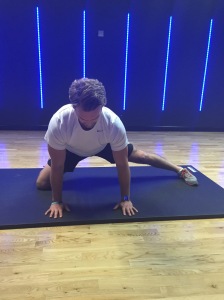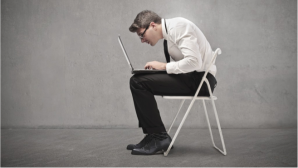Lower back pain (LBP) is a common disorder that the majority of people and athletes have experienced at one point in their lives. For some people it stops them being able to do their jobs and/or stops them from training and staying fit. Which in turn can lead to chronic pain later on in life and/or weight gain. I have also treated and trained a large number of people who have or have had LBP. Two common causes for lower back pain (LBP) are being sat down at a desk for hours every day as well as from incorrect technique during heavy exercise. This in turn leads people to think that LBP is the norm and it’s part of everyday life, but it’s not.
There are fewer cases of reported LBP in less developed countries as their posture and biomechanics haven’t been ruined from sitting. However, as less developed countries become more urbanised and commercialised the incident of LBP is on the rise. People are spending more time in office jobs stuck in their chairs and less in manual labour jobs outside. This doesn’t mean I’m telling everyone you can never sit at your desk again. That would be simply unrealistic as most people earn their living that way, in this article I will explain some of the reasons as to why LBP happens. I will also show you a number of simple exercises that you can incorporate in your everyday life to help treat and prvent LBP.
Joint-by-Joint Approach – Mobility v Stability
One of the main causes that I’ve observed with my clients getting LBP (more specifically in their lumbar spine) is not because their lumbar spine is weak, it’s because their lumbar spine is compensating for a lack of mobility and/or stability in another part of the body.
To help understand how joint pain occurs and how the body moves, the Joint-by-Joint approach was developed by Gray Cook and Michael Boyle. Cook and Boyle describe how the human body works as a stack of joints, with each
joint needing more stability or mobility than the one above or below it. To read more about the Joint-by-Joint approach click on this link http://graycookmovement.com. Below I’ve gone over the basics of this approach and how it applies to LBP.
Here are main joints in the body, working from top to bottom showing if mobility or stability is more important for pain free and correct movement.
- Gleno-humeral (shoulder) – Mobility
- Scapula (shoulder blade) – Stability
- Thoracic Spine (Upper Back) – Mobility
- Lumbar Spine (lower Back) – Stability
- Hip – Mobility
- Knee – Stability
- Ankle – Mobility
- Foot- Stability
Injuries and joint pain are closely linked to correct joint function. Dysfunction at one joint will lead to a pain or an injury at the joint above and below. An example is lack of ankle mobility leads to knee pain. This is very common with Athletes who strap their ankles to make them more stable from fear of twisting (e.g. Basketball players). This does however restrict the movement at the ankle which becomes less mobile and more stable. This forces the joint above the knee to compensate for lack of movement at the ankle and it becomes too mobile and less stable, the knee joint tries to rotate and can lead to a serious knee injury (common injury from this is MCL/ACL damage).
Hip Mobility
By using the Joint-by-Joint Approach above we can see that LBP can be caused by a lack of mobility at the hips. This lack of hip mobility causes the hips to be very stiff. This leads to an increase of mobility and increased movement at the Lumbar spine, which is not good. The Lumbar spine is designed to mainly be stable but when it becomes too mobile we tend to get LBP. (Imagine your lower back is a thin piece of wood, if you then keep bending back and forth for a long time it’s going to snap – back pain!) The main causes for the hips being very stiff and immobile is due to long periods of sitting everyday and/or by regularly exercising heavily without stretching. The hip is designed to be a very mobile joint, which enables your lower body to move in multiple plans while transferring large amounts of force. When the hips lose this mobility and range of motion, the lower back compensates to this lack of movement. Therefore having mobile hips is very important for having a healthy lower back and for performance in the gym and out on the sports field.
Here are a few stretches will help improve your hip mobility when done on a daily basis.
Hip Flexor Stretch

Place right foot on a swiss ball behind you; come onto 1 knee with your left foot flat on the floor out in front. Move your hips back so there is a small gap between your bottom and back foot, and squeeze your Glute on your back leg (squeeze your buttocks as hard as you can) and if done correctly you will feel an aggressive stretch in your back quad and the front of your hips. The aim of this stretch is to release your hip flexors (Rectus Femoris, Psoas and Iliacus). Perform this stretch for 30 seconds on each leg and repeat twice.
Modified Pigeon Pose
Start in a press up position. Bring the right knee forward and place next to the right hand on the floor, and your left foot as close to your left hand as you can. Let your body relax and hips lower to the floor and either rest on your hands or elbows and arms for a more advanced stretch. Let the back leg (left) relax with your left foot laces down. The aim off this stretch is too release your hip extensors (piriformis, Gluteal Group). Perform this stretch for 30 seconds on each leg and repeat twice.
Hip Adductor Stretch


Start on all fours. Place your left leg out to the side and keep your left knee locked out. Maintain a neutral spine throughout the stretch. Support your weight through your hands and rock your hips back towards your heel and forward towards of the floor. You should feel the muscles on the inside of the left leg stretch. Perform this stretch for 30 seconds on each leg and repeat twice.
Anterior and Lateral Core stability
The other common cause of LBP is from having weak muscles in your anterior and lateral core. You might have often heard people say your need to strengthen your ‘core’ muscles. But what does core actually mean? This core basically means muscles that connect your lower ribs to your pelvis and Lumbar spine, which run down the side and front of your torso. Not just your ‘abs’. The main muscles that make up the ‘anterior and lateral core’ are External obliques, internal obliques, Rectus abdominis, and Transverse abdominis. There are spinal extensor muscles that stabilise the spine but in the majority of people these are not the muscles that lack strength. Is it when these core muscles become inactive and weak and along with poor hip mobility that people tend to experience lower back pain. These muscles stabilise the lumbar spine and during exercise and movement enable a smooth and powerful transfer of force through spine to the external regions of the human body. Having a stable lumbar spine and strong muscles in anterior and lateral core is like building a house with strong foundations. If you don’t build the strong foundations the house will fall apart. If you don’t stabilise and strength the lumbar spine and muscles around it, the human body and lower back will suffer from pain and most likely you will get an injury.
Once you have stretched out your hips, next you need to stabilise the lumbar spine. Here are a few exercises you can do to strengthen your ‘core’.
Deadbugs –Anterior Core Stability
Lie flat on your back, feet and arms in the air with knees at right angles. Brace your stomach muscles, pull your ribs down and flatten your lower back against the floor with your stomach muscles. Imagine someone is about to punch you in the stomach, and you have to tense your stomach muscles. Maintain the tension in your stomach and straighten 1 leg out at a time while maintaining a flat lower back. Do 10 reps on each leg, rest and then repeat 3 times. If your lower back starts to arch, rest and then do the same number of rests with out arching your back. If done correctly you will feel this down the front of your stomach.
Side Plank – Lateral Core
Lying on your side with your foot and forearm in contact with the floor. Maintain a neutral spine. Brace your core with the same technique as Deadbugs, ribs downs and squeeze your glutes and quads. Imagine someone is about to kick you in the stomach. Hold for 30-40 seconds each side. Repeat 3 times. If you struggle to hold the side plank for 30 secs from your feet, drop your bottom knee down to the floor so your forearm and knee are in contact with the floor
Perform the hip stretches and core exercises everyday twice a day. Even if you don’t have LBP and spend the majority of your day sat down still incorporate these exercises into your workouts. If you lift weights and exercise regularly these exercise should be part of your programme already. It will only take 10minutes so you can easily fit it into your day. You can do them as part of your warm up before your gym session. If your warm up consists of 5minutes on a cross trainer, then replace the cross trainer with these exercises. Doing 5minutes of cardio before any sessions is not a warm up especially if you have LBP. You need to mobilise and stabilise the joints so they are ready to transfer force efficiently and correctly. If you’re doing a strength session you can also perform these exercises in your rest periods. For example if you have tight hips and are doing heavy squats, you can do one of the hip stretches in your rest period instead of checking twitter on your phone.
There will be more complicated and serious cases of LBP where these exercises won’t be able to help. In these situations seek help from a fully qualified Osteopath or Physiotherapist.
The Gluteal muscle (buttocks) also play an important role in preventing LBP. In my next article I will go over how the glutes improve sports performance and injury prevention. The stronger your glutes the faster you can run, heavier you can squat and less likely you are get lower back pain and knee injuries.





